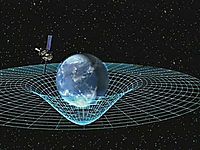
Photo from wikipedia
One major concern in the design and operation of high-intensity rings is beam loss due to beam halo. Another issue of importance in applications involving fixed targets is the uniformity… Click to show full abstract
One major concern in the design and operation of high-intensity rings is beam loss due to beam halo. Another issue of importance in applications involving fixed targets is the uniformity of the beam energy deposition on the target. Both of these issues could be favorably addressed by a hard-edged beam with uniform transverse density. This paper presents a detailed feasibility study for painting such a beam into a high-intensity proton ring. For the purposes of this paper, we define self-consistent beams to be ellipsoidal, or elliptical in 2D, distributions that have uniform density and linear space charge force and that retain these properties under all linear transformations. Because of their linear space charge forces and linear transport properties, self-consistent distributions may undergo very little halo formation if realized in practice. Because of their uniform density, they would have smaller maximum space charge tune shifts than peaked density distributions, and they would be attractive for high-intensity fixed target applications. Selfconsistent distributions involve very special relationships between the phase space coordinates, making them singular in some respects and difficult to realize experimentally. The most famous self-consistent distribution is the Kapchinsky-Vladimirsky distribution, but now many other self-consistent distributions have been discovered. One such, the 2D rotating distribution, can be painted as a coasting beam into a ring having an appropriately designed and tuned lattice. For bunched beams, if the bunch length is sufficiently long, it is expected that the coasting beam assumption will be a good approximation during painting. However, it is unknown how robust self-consistent distributions will be under real world transport in the presence of nonlinearities and collective effects. This paper studies these issues for a particular case of interest by applying realistic detailed computational models to the simulation of painting a self-consistent rotating beam into the Spallation Neutron Source (SNS) ring. As a result, we propose a case that can be carried out with only a minor modification of the SNS hardware.
Journal Title: Physical Review Accelerators and Beams
Year Published: 2018
Link to full text (if available)
Share on Social Media: Sign Up to like & get
recommendations!